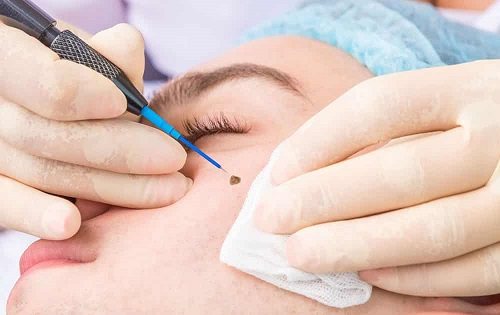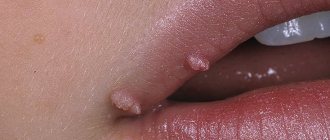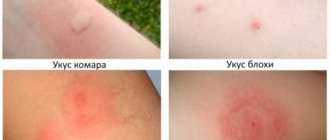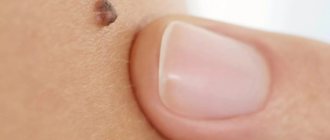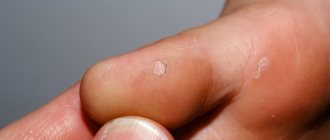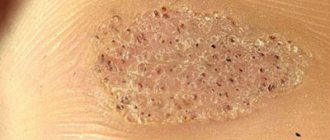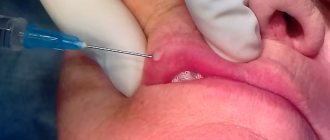Why does a wart itch?
Increased itching may occur as growths grow due to decreased immune system function, so you should immediately consult a doctor for diagnosis and treatment.
Most people with warts or papillomas do not pay attention to such skin growths until they begin to manifest themselves in some way: itching, changing color and shape, and hurting. The skin around the growth itself may also turn red.
Most often, a wart that itches is located in an area with a large number of nerve endings (for example, on the genitals, palms, or fingertips). In this case, a feeling of itching may accompany the patient even after removal of the growths. The reason may be one of the following factors:
- the protective mechanism of the skin has decreased;
- if the warts itch after removal, it means that the growth has not been completely removed;
- the wound surface became infected after removal (in this case, itching around the affected area will be felt);
- an active surface healing process has begun after removal of the papilloma with a radio or laser instrument;
- a chemical burn to the skin resulting from the use of aggressive folk methods (celandine, acetic acid, etc.).
Why does a wart itch before the patient or doctor intervenes? This may be caused by one of the following:
- the virus has entered the stage of active reproduction, which affects healthy skin cells - the wart increases in size or a new one appears;
- mechanical damage to the growth (very often warts can be rubbed by clothing, squeezed by body parts, etc.);
- insufficient intimate hygiene (most often itchy warts and papillomas that are located on the genitals, in the armpits, near the anus);
- infectious and inflammatory pathologies;
- with the mutation of benign warts into malignant ones.
Why do warts hurt?
Why does a wart hurt? Mostly these growths appear on the arms or legs. These are the places that are most susceptible to injury. For this reason, warts often hurt.
If a growth appears on the hands, then a person may accidentally damage it during the work process. And you can understand what’s wrong only by examining the injured area. It is worth adding separately that upon contact with harmful substances that may be present in a person’s workplace, the growth can cause complications for the body.
Getting rid of warts on your own is very dangerous.
If such an injury occurs, the formation should be immediately treated with hydrogen peroxide and consult a doctor. You should not try to get rid of a damaged wart on your own. It is important to remember that a wart is a benign neoplasm that can develop into a malignant tumor at any time, and the main factor can be a common injury to this area of the body. If a growth injury occurs, this is a much more serious problem. There is no point in postponing its treatment, and the defect cannot be eliminated at home. The most ideal option is to quickly remove the growth immediately after it is discovered on the human body.
If a wart appears on your toe or its location is the foot, you need to understand that this can lead to injury with all the ensuing consequences.
The second option is to enlarge the affected area of the body. It is no secret that the growth may begin to increase, as a result of which a person will soon be unable to stand on his leg. The growth may become inflamed, causing severe pain and making it impossible to wear shoes.
It is worth adding separately that when growths appear in places such as limbs, they should be disposed of immediately, since wearing ordinary clothes very often causes injury to the tumor. As a result, it begins to bleed and may become inflamed, which will lead to serious consequences.
Diagnostics
The main diagnostic method is visual examination. If necessary, the doctor may prescribe related tests:
- PCR, or polymerase chain reaction. This method allows you to identify the DNA of the papilloma virus in the human body, its type and quantitative ratio. One of the following biological fluids may be taken for examination: blood, urine, salivary gland secretions, amniotic fluid, or scrapings from the urethra or cervix.
- Daijin test. This is a highly sensitive analysis that is carried out in order to determine the oncogenicity of the virus and specifically its strain. It uses exclusively scrapings from the urethra or vagina. Such a test is a reliable way to detect the concentration of the virus in the body, because this indicator best reflects the risk of cell mutation into cancer. Only a doctor can interpret the result obtained; you should not look at its transcript in other sources.
If the wart grows and itches, you should get diagnosed immediately.
Diagnostic cost

To diagnose warts, the patient should make an appointment with a dermatologist and follow his further instructions.
If papillomas begin to manifest themselves or simply form abundantly on any area of the skin, you should consult a dermatologist. The cost of the consultation will be approximately as follows:
- Primary reception – 1800-2000 rubles.
- Repeated appointment costs about 1000 rubles.
- Calling a specialist to your home costs about 3,000 rubles.
- Drawing up a treatment plan – 500-600 rubles.
- Inspection with a Wood's lamp - 400-500 rubles.
- Dermatoscopy – up to 3000 rubles + biopsy sampling – about 500 rubles.
- Colposcopy – from 700 to 1500 rubles.
- Cytology – up to 2500 rubles + smear – about 500 rubles.
- PCR analysis – up to 2000 rubles.
What to do if a wart itches
-Warts
Warts are benign formations, some of which remain on a person’s skin throughout life without changing color, shape or size. Their presence is expressed only as a cosmetic defect on the dermis. If a wart itches, there is reason to think; there can be many reasons for this phenomenon. Treatment or removal of the growth may be required.
Why can a wart itch?
Do you need advice from an experienced doctor? Get a doctor's consultation online. Ask your question right now.
Ask a free question
Warts appear on the skin due to the activity of the human papillomavirus (HPV), which entered the body through sexual contact or household contact (using the patient’s belongings, infection when visiting public swimming pools, saunas). Papillomas and condylomas that are viral in origin can be removed from the skin after being examined by a doctor. The formations pose a danger to the patient and carry the risk of infecting other people.
Dermatologists have named the reasons why the growth may itch:
- Weakened immunity, as a result of which the virus begins to become more active, causing the growth of new warts.
- Changing the appearance of the growth.
- Injury to the growth with a razor, during epilation, touching it with clothes, jewelry, rubbing with shoes.
- Poor hygiene if the growth is located under the armpits, in the groin or anus.
Most often, itching is caused by warts located on the fingers, groin, head, armpits, face, neck, back, legs, heels, arms, palms.
The feeling of itching is present due to activation of the virus, infection of the wound, chemical burn of healthy body tissues, the healing process after eliminating the bulge using diathermoelectrocoagulation or laser.
Danger
If the elements itch, do not comb the skin, it can lead to serious consequences:
- development of the inflammatory process;
- infection of dermal cells;
- formation of scars, cicatrices;
- spread of virus cells to healthy tissues, which provokes the growth of new formations;
- bleeding.
When scratching a lump on the skin, there is a risk of foreign infection entering the bloodstream, which can lead to inflammation and worsening the patient’s well-being.
If the formation begins to itch, turn red, increase in size, or blurred boundaries are observed, then you need to consult a doctor.
The doctor will decide whether there is a need for surgical removal or whether antiviral drugs and pharmaceutical cauterization agents can be used.
Diagnosis of itchy growth
If the growth causes discomfort, pain, bleeds or itches, you need to go to a dermatologist. To make a diagnosis and determine the type of wart on the dermis, the doctor conducts an examination and, if necessary, sends the patient for tests:
- PCR (polymerase chain reaction) to determine the type of virus and its quantity in the human body. They take fingerprints.
- Histology. Tissue removed from a plantar or other wart is sent for examination to determine its nature and the presence of cancer cells.
Flat, convex tubercles on the dermis, which are often exposed to ultraviolet radiation, are injured, rubbed by clothing or shoes, require special attention.
How to treat a wart that itches
To get rid of itching, dermatologists advise using pharmaceutical preparations:
- Nezulin.
- Akriderm.
- Mesoderm.
- Pimecrolimus.
- Iricar.
Folk remedies help eliminate discomfort:
- Chamomile with a string. A mixture of two herbs is brewed, the composition is infused for two hours, then gauze is moistened in it and attached to the sore spot.
- Garlic. The clove is cut in half, its cut is applied to the affected area.
- Bath with soda. A foot bath using warm water and soda helps eliminate itching; the lower limbs are dipped into it, steamed, and the top layer of the wart is cleaned off with pumice.
- Celandine. The juice of the plant removes itching and the formation itself.
- Kalanchoe. Apply the leaves of the plant to the growth for a week.
If the wart has already been scratched, you need to treat it with antiseptic medications: iodine, alcohol, hydrogen peroxide, castor oil.
What symptoms should you see a doctor for?
Constant itching in the area of education is a reason to consult a doctor. The symptom may indicate inflammation of a flat or raised growth on the skin.
Signs of wart inflammation:
- bleeding of the formation and the area of skin around it;
- change in size, color, shape, blurring of boundaries;
- rapid growth on the skin;
- sensation of pain, itching in the area of the wart;
- swelling of the tubercle, sharp redness or darkening.
Most doctors advise removing growths that itch not with pharmaceutical drugs or folk remedies, but in a hospital setting using the following methods:
- Cryodestruction or cauterization with liquid nitrogen.
- Laser therapy.
- Radio waves.
- Surgical excision.
- Diathermoelectrocoagulation.
The appearance of moles and other bumps on the skin is not always a lucky sign. Any points on the skin require observation and care; they should not be combed, picked, or removed with pumice or scrubs. If a person experiences frequent discomfort, he should visit a doctor.
Possible complications and precautions
To avoid wart inflammation, doctors advise taking precautions:
- Introduce physical activity into your life and strengthen the body’s protective functions.
- Walk more in the fresh air.
- Eliminate alcohol and tobacco products from use.
- Take care of those areas of the dermis where growths and moles are located, trim your nails regularly, and wear clothes made of soft, pleasant-to-touch materials.
- After a shower, do not dry yourself with a towel, but gently pat your body with it.
- Go on a healthy diet, take vitamins.
- Observe hygiene rules.
- Establish a sleep and rest routine.
- Do not use other people's things, clothes, towels, shoes, combs, bed linen, pillows.
- Control your weight and try not to experience stress.
- Treat infectious and chronic diseases in a timely manner.
Such preventive measures will help avoid the appearance of growths on the skin and problems with them.
The wart rarely itches, hurts, changes color and shape without serious reasons. Signs indicate that it urgently needs to be removed with medical help. Formations that do not itch, do not cause other unpleasant sensations, are not a cosmetic defect and are located on inconspicuous parts of the body do not need to be removed.
The article has been reviewed by the site editors Link to the main publication
Didn't find suitable advice?
doctor or see all questions...
articles:
(2 5,00 of 5) Loading...
Source: https://VashaDerma.ru/borodavki/cheshutsa
How to relieve itching?
If severe irritation and itching occurs around the wart, you should immediately consult a specialist. If you scratch an itchy area too much, the wart can not only be damaged, but also spread to the injured tissue.
Before full treatment, discomfort can only be reduced for a short time. Here are some tips:
- If warts on your body itch very much, you should start wearing clothes made from natural fabrics. Synthetic and woolen products will increase itching.
- Touch the papilloma as little as possible so as not to injure the area or irritate it.
- To relieve itching, you can use lotions based on celandine, chamomile and string. Apply a cotton pad soaked in the broth in the morning and evening to previously cleansed skin; this will have an antiseptic and anti-inflammatory effect.
- Warts can be lubricated with iodine and then with castor oil. It neutralizes itching and pain.
- Maintain personal hygiene regularly. You should wash carefully: if a wart on your back itches, it can be easily injured during bath procedures.
If you can’t visit a doctor in the near future, you can relieve the feeling of itching with the following medications:
Even more interesting:
Tongue with HIV infection photo
Yarina or Dimia
- menthol oil;
- diphenhydramine;
- tar;
- carbolic acid;
- iodine.
These agents also have antiseptic and anti-inflammatory effects. In addition, the first aid kit of a patient with papilloma virus should contain the following medications:
- Ferezol ointment is a special remedy for warts for external use. It has an oily consistency and has a disinfecting and cauterizing effect.
- Antiallergenic oral drugs of the 3rd generation (Diazolin, Citrine, etc.).
- Antiviral drugs whose active substance is interferon. It is effective against further spread of papillomas and warts.
- Immunostimulating drugs. Taking them significantly increases the effectiveness of other treatments.
- Oxolinic ointment. “Freezes” painful sensations after 10 days of regular use.
How to prevent papillomas from picking off
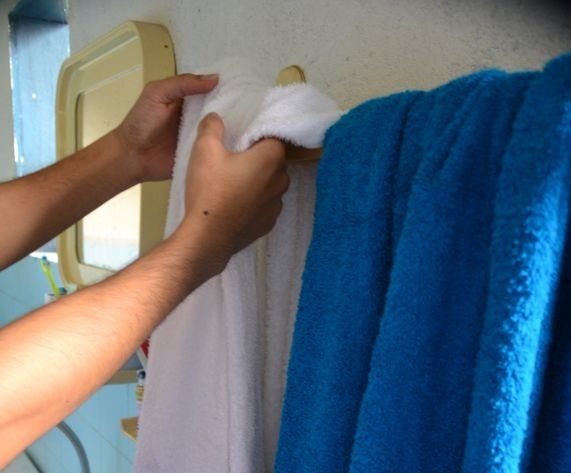
To further prevent accidental damage to warts, it is necessary to choose a safe length of nails and trim them in a timely manner. You also need to wear loose-fitting clothes that will not fit tightly to the body and put pressure on the skin, especially in places where papillomas appear.
In the shower, use soft washcloths and gently dry your skin with a towel so as not to injure existing warts on the body. If any of the tumors, due to their size or location on the body, causes significant discomfort, it is better to think about removing it. To do this, you can use local agents or go to a specialized clinic, where the wart will be removed quickly and almost painlessly.
Why is itching around warts dangerous?

If the wart is itchy, you should not comb it, rip it off or otherwise influence it; these actions often lead to the appearance of scars and welts, the spread of the virus to healthy areas of the skin and the appearance of new formations
No matter how strong the itching sensation, it is strictly forbidden to scratch warts or papillomas. The result of this may be a violation of the structure of the neoplasm, after which it may change shape, color, structure, size. In addition, the following dangerous factors can be identified:
- Activation of the vital activity of the virus leads to intoxication of the human body and accelerated damage to the skin.
- Against the background of weak immunity, a secondary infection may occur, which provokes an inflammatory process in the wart itself and surrounding tissues through scratching the skin.
- Violation of the integrity and structure of the wart can trigger the activation of the papilloma virus, which over time can cause cancer.
What to do if you have already scratched a wart?
After this, you should consult a dermatologist as soon as possible, since the risk of infection remains high and the affected injured area must be monitored. The doctor will also prescribe medication and means for further surface treatment.
Growths on the body do not always pose a threat to humans; in some cases they can go away on their own. But if the wart itches and hurts, this can be a serious cause for concern, as this often leads to bleeding and the spread of infection.
What happens if you cut off a wart?
Probably, many have wondered: “is it possible to cut or tear off a wart” and what will come of it? The correct answer to this question is no, you can't. Cutting off warts on the body on your own is highly discouraged, as this procedure entails several negative consequences for human health:
- The appearance of warts on the body is characterized by the proliferation of blood vessels and capillaries that feed it. If you cut off the top layer of a wart, these vessels are also damaged, which leads to heavy bleeding that is not so easy to stop.
- The main cause of the spread of papillomas is a virus (HPV), and if infected blood gets on healthy areas of the skin, then with a high degree of probability new papillomas may appear in this place, especially if the immune system is weakened due to a change of season or disease.
- Tearing off or cutting off a wart does not go away without a trace and noticeable scars and cicatrices form in this place. The neoplasm has its roots deep into the skin, so mechanical removal is not an effective method. Numerous photos on the Internet clearly demonstrate the negative consequences of such self-medication.
- In addition to the appearance of scars, an infection may develop at the site of the torn wart. The upper layers of the epidermis are damaged and become susceptible to various pathogenic bacteria that are found on the surface of the human body and in the environment. With a weakened immune system, the development of a bacterial infection may be accompanied by an increase in body temperature and other dangerous symptoms. This will require additional cash costs for the purchase of antibiotics, not to mention the consequences for human health.
Why do warts itch?
Main reasons
Why do warts itch? In fact, this can happen for various reasons, the main ones being:
- Changes and growth of the tumor, active spread of the virus, this is often observed when the immune system is weakened.
- Degeneration of a benign tumor into a malignant one.
- Injury to the growth, for example due to friction or pressure.
- Neglect of personal hygiene, especially in the armpits, anus or reproductive organs, can lead to itching.
- Infectious and inflammatory process.
Important! A dermatologist diagnoses the type of formation, prescribes the necessary treatment and prescribes medications.
Localization of itching
Most often, warts itch if they are located on parts of the body that have many nerve endings, such as:
- Fingertips.
- Face, tongue and neck.
- Lower limbs and feet.
- Arms and armpits.
- Hair part of the head.
- Genital organs.
Itching after wart removal
Do warts, or rather the place where they are removed, itch after the growth is removed? In fact, itching can occur, and most often this happens for the following reasons:
- Activation of HPV (the virus that causes warts and papillomas) after incomplete destruction of the growth or deterioration of the natural protection of the skin.
- Infection of skin areas where there were wounds after surgery.
- Healing of the lesion site after electrocoagulation or laser removal of the wart.
- Chemical burn resulting from treatment with acetic acid, celandine and similar aggressive components.
Often, for a number of reasons, itching occurs at the site of the removed wart.
Where does the itching come from?
Unpleasant sensations in the wart area can occur for several reasons.
- Increasing the affected area: Itching occurs when the virus attacks healthy skin cells. In this case, the element itself either increases in volume or gives rise to “daughter” foci.
- Healing of the wound surface: warts can be injured, and as the wound site epithelializes, itching is also observed.
- Unfortunate location: warts can itch in folds of skin where there is excess moisture (armpits, perianal area).
- Malignancy: warts with regular damage can extremely rarely degenerate into a malignant neoplasm. At the same time, they change their color and shape, begin to grow actively, and can not only itch, but also hurt and bleed. Hair may fall out from adjacent areas of the skin.
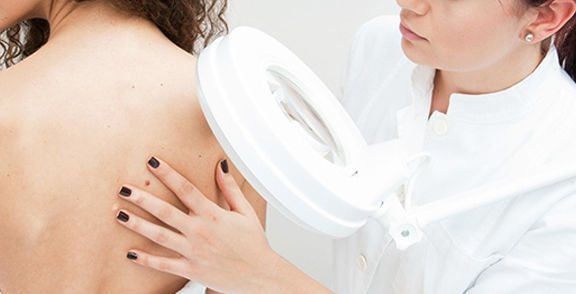
During an examination, a dermatovenerologist will determine exactly why the wart is itching. As a rule, papillomas located in places rich in nerve endings itch - the fingertips, the perianal area.
Is it possible to scratch a wart?
Sometimes the growths cause painful, tickling sensations, but scratching the growth is strictly prohibited. As a result of scratching, the following may appear:
- Inflammation.
- Heavy bleeding.
- The spread of infection to healthy cells, the appearance of new warts.
- Scar formation.
- Infection of cells.
Important! Even if the wart begins to itch, you should never rub it, as this can lead to the spread of infection throughout the body.
In addition, scratching the growth can provoke additional infection into the blood, which will only worsen the patient’s condition.
If the papilloma is still damaged, it is necessary to treat the affected area with an antibacterial agent, for example, iodine or hydrogen peroxide, as quickly as possible, and then apply a patch.
Important! Even after treating the affected area, you should consult a doctor to eliminate the risk of infection.
Causes of itching of warts, possible complications
If the wart itches, it can be scratched and traumatized, which often leads to the appearance of new growths or inflammation. But there are other complications.
These include:
- the growth has come off (occurs when located on the back);
- the occurrence of bleeding of the formation;
- the wart has turned black.
In such cases, you cannot hesitate. The appearance of blood is explained by the fact that the formation begins to increase, small vessels appear in it that feed it. When they are damaged during the combing process, bleeding occurs. The surface should be treated with peroxide solution and a sterile bandage applied. A change in color serves as a dangerous signal of possible malignancy. Therefore, you should not postpone your visit to the doctor.
Signs of a malignant tumor
Melanoma symptoms
It is extremely rare for a benign tumor to transform into a cancerous tumor. However, it is necessary to know about the symptoms of oncology in order to avoid irreversible consequences.
A sharp darkening of a wart may be a symptom of a malignant tumor
Important! Melanoma is a cancerous tumor that can only be cured in its early stages. One of the symptoms of the disease is itching of the skin, so if the wart itches, you should consult a doctor to clarify the nature of the formation.
Signs of a malignant tumor:
- Painful sensations.
- Dark color of the wart.
- Self-removal of the formation, after which the affected area continues to itch.
- Swelling and redness around the growth.
- Bleeding and wounds on papilloma.
Reasons for conversion
An ordinary wart can transform into a malignant formation under the influence of the following factors:
- Heredity.
- The effect of ultraviolet radiation on the skin.
- Burns.
- Damage to the skin.
- Unfavorable environment.
Medical examination
Diagnosis of the disease begins with a visual examination and determination of the type of growth. Sometimes the dermatologist refers the patient for additional examinations:
- PCR (polymerase chain reaction) analysis to determine the degree of oncogenicity, the type of virus and its approximate content in the patient’s body.
- Histological analysis to determine whether the lesion is cancerous.
Particular difficulties can arise with the diagnosis of a plantar wart, since it can easily be confused with a dry callus.
Plantar warts are often confused with calluses
Prevention methods
Wart growths appear on the body due to a weakened immune system, so the main methods of prevention are focused on preventing infection and improving immunity. To do this you need:
- Do physical exercise and strengthen your body.
- Stop smoking and drinking alcohol.
- Be outdoors more often.
- Try not to injure the wart: trim your nails, wear soft things that are not close to your body, and dry yourself carefully with a towel.
- Eat right, follow the diet prescribed by your doctor.
- Carry out bath procedures more often to avoid irritation.
- Take vitamin complexes.
- Try not to use other people's things, especially a comb, razor or towel.
- Control your emotional state, avoid stressful situations.
- Have a full rest. Night sleep should last at least 7 hours.
- Promptly treat foci of chronic infection. The consequence of a negligent attitude towards one’s health can be the penetration of the virus into the body and the deterioration of the immune system.
What to do if warts start to itch
Growths on the body do not always pose a threat to humans; in some cases they can go away on their own. But if the wart itches and hurts, this can be a serious cause for concern, as this often leads to bleeding and the spread of infection.
Main reasons
Why do warts itch? In fact, this can happen for various reasons, the main ones being:
- Changes and growth of the tumor, active spread of the virus, this is often observed when the immune system is weakened.
- Degeneration of a benign tumor into a malignant one.
- Injury to the growth, for example due to friction or pressure.
- Neglect of personal hygiene, especially in the armpits, anus or reproductive organs, can lead to itching.
- Infectious and inflammatory process.
Important! A dermatologist diagnoses the type of formation, prescribes the necessary treatment and prescribes medications.
Localization of itching
Most often, warts itch if they are located on parts of the body that have many nerve endings, such as:
- Fingertips.
- Face, tongue and neck.
- Lower limbs and feet.
- Arms and armpits.
- Hair part of the head.
- Genital organs.
Itching after wart removal
Do warts, or rather the place where they are removed, itch after the growth is removed? In fact, itching can occur, and most often this happens for the following reasons:
- Activation of HPV (the virus that causes warts and papillomas) after incomplete destruction of the growth or deterioration of the natural protection of the skin.
- Infection of skin areas where there were wounds after surgery.
- Healing of the lesion site after electrocoagulation or laser removal of the wart.
- Chemical burn resulting from treatment with acetic acid, celandine and similar aggressive components.
Often, for a number of reasons, itching occurs at the site of the removed wart.
Is it possible to scratch a wart?
Sometimes the growths cause painful, tickling sensations, but scratching the growth is strictly prohibited. As a result of scratching, the following may appear:
- Inflammation.
- Heavy bleeding.
- The spread of infection to healthy cells, the appearance of new warts.
- Scar formation.
- Infection of cells.
Important! Even if the wart begins to itch, you should never rub it, as this can lead to the spread of infection throughout the body.
In addition, scratching the growth can provoke additional infection into the blood, which will only worsen the patient’s condition.
How to get rid of filamentous warts, expert advice
If the papilloma is still damaged, it is necessary to treat the affected area with an antibacterial agent, for example, iodine or hydrogen peroxide, as quickly as possible, and then apply a patch.
Important! Even after treating the affected area, you should consult a doctor to eliminate the risk of infection.
If treatment for warts and papillomas is not started on time, then in advanced stages they develop into...
Read more
Melanoma symptoms
It is extremely rare for a benign tumor to transform into a cancerous tumor. However, it is necessary to know about the symptoms of oncology in order to avoid irreversible consequences.
A sharp darkening of a wart may be a symptom of a malignant tumor
Important! Melanoma is a cancerous tumor that can only be cured in its early stages. One of the symptoms of the disease is itching of the skin, so if the wart itches, you should consult a doctor to clarify the nature of the formation.
Signs of a malignant tumor:
- Painful sensations.
- Dark color of the wart.
- Self-removal of the formation, after which the affected area continues to itch.
- Swelling and redness around the growth.
- Bleeding and wounds on papilloma.
Reasons for conversion
An ordinary wart can transform into a malignant formation under the influence of the following factors:
- Heredity.
- The effect of ultraviolet radiation on the skin.
- Burns.
- Damage to the skin.
- Unfavorable environment.
Medical examination
Diagnosis of the disease begins with a visual examination and determination of the type of growth. Sometimes the dermatologist refers the patient for additional examinations:
- PCR (polymerase chain reaction) analysis to determine the degree of oncogenicity, the type of virus and its approximate content in the patient’s body.
- Histological analysis to determine whether the lesion is cancerous.
Particular difficulties can arise with the diagnosis of a plantar wart, since it can easily be confused with a dry callus.
Plantar warts are often confused with calluses
Prevention methods
Wart growths appear on the body due to a weakened immune system, so the main methods of prevention are focused on preventing infection and improving immunity. To do this you need:
- Do physical exercise and strengthen your body.
- Stop smoking and drinking alcohol.
- Be outdoors more often.
- Try not to injure the wart: trim your nails, wear soft things that are not close to your body, and dry yourself carefully with a towel.
- Eat right, follow the diet prescribed by your doctor.
- Carry out bath procedures more often to avoid irritation.
- Take vitamin complexes.
- Try not to use other people's things, especially a comb, razor or towel.
- Control your emotional state, avoid stressful situations.
- Have a full rest. Night sleep should last at least 7 hours.
- Promptly treat foci of chronic infection. The consequence of a negligent attitude towards one’s health can be the penetration of the virus into the body and the deterioration of the immune system.
How to get rid of papillomas and warts? The main components of good health
Methods for removing growths
The itching of a wart causes enormous psychological discomfort, and constant scratching can promote bleeding, spread the virus throughout the body and transform into a malignant tumor. The choice of treatment method depends on the type, number and location of warts. The most commonly used methods are:
- Radio wave removal using a special device “Surgitron”. Often used to remove papillomas in the genital area. The rehabilitation period lasts 1-2 weeks.
- Electrocoagulation – removal of a tumor with high-frequency current. Scars may remain after the procedure.
- Laser grinding. The most favorite method of removal among patients, since the procedure is sterile and practically painless, and after the operation there are no scars or scars.
- Cryotherapy – freezing the growth using liquid nitrogen. Complete healing of the area can take up to 6 months.
- Surgery with a scalpel is the most traumatic method and is used only in extreme cases. After the operation, scars remain and an inflammatory process may begin. Therefore, it is necessary to follow all doctor’s recommendations.
- Chemical cauterization using preparations that contain aggressive components, in particular alkalis and acids. The most famous remedy is Celandine.
- Freezing using special medications, for example, Cryopharm or Wartner Cryo.
Regardless of the chosen method, it is recommended to take medications to improve the body’s natural defenses, vitamins and antiviral agents.
Ways to remove warts
Medicines for itching
When a wart itches , the doctor may prescribe antipruritics in the form of ointments, creams and special gels. For patients with dry skin, fatty ointments with a cooling effect are more suitable; for people with normal or oily skin types, gels, creams and tinctures are more suitable. Complex drugs with antiallergic properties help very well.
Removing warts with celandine and super celandine
The most popular ointments for itching:
- Pimecrolimus is a cream for external use.
- Akriderm - available in the form of cream and ointment.
- Mesoderm - ointment.
- Iricar - sold in the form of ointment and cream.
- Nezulin - cream-gel.
Alternative medicine methods
If the growth is constantly itchy, you can try using traditional methods, but you should first consult a doctor.
The most well-known methods are:
Regular garlic will help fight warts
- Steam 1 tablespoon of chamomile with a string in a glass of hot water, leave for 2 hours. Dip a piece of cloth into the resulting infusion and attach it to the affected area as a bandage.
- Place the cut side of a clove of garlic on the growth and secure with a band-aid.
- Steam your feet (for plantar warts) in warm water with soda, then remove the keratinized layer with pumice.
- Brew 3 tablespoons of wormwood flowers in 200 g. boiling water, leave for 2-3 hours and make compresses. This method will help get rid of the growth and prevent itching.
- Lubricate the damaged area with celandine juice. If the use of the plant caused irritation and pain, treatment should be stopped.
- Press Kalanchoe leaves onto the new growth for one week.
Let's sum it up
Important!
Many people live with warts and papillomas, not even suspecting that they are already infected with this dangerous...
Read more
An unpleasant and painful itching of a protruding growth most often indicates inflammation, mechanical damage and tumor growth. In this case, measures must be taken immediately, since scratching the wart can lead to inflammation, bleeding and the spread of the human papillomavirus throughout the body.
Source: https://bolezni-kozhi.ru/borodavka-cheshetsya.html
Treatment of warts
Methods for removing growths
The itching of a wart causes enormous psychological discomfort, and constant scratching can promote bleeding, spread the virus throughout the body and transform into a malignant tumor. The choice of treatment method depends on the type, number and location of warts. The most commonly used methods are:
- Radio wave removal using a special device “Surgitron”. Often used to remove papillomas in the genital area. The rehabilitation period lasts 1-2 weeks.
- Electrocoagulation – removal of a tumor with high-frequency current. Scars may remain after the procedure.
- Laser grinding. The most favorite method of removal among patients, since the procedure is sterile and practically painless, and after the operation there are no scars or scars.
- Cryotherapy – freezing the growth using liquid nitrogen. Complete healing of the area can take up to 6 months.
- Surgery with a scalpel is the most traumatic method and is used only in extreme cases. After the operation, scars remain and an inflammatory process may begin. Therefore, it is necessary to follow all doctor’s recommendations.
- Chemical cauterization using preparations that contain aggressive components, in particular alkalis and acids. The most famous remedy is Celandine.
- Freezing using special medications, for example, Cryopharm or Wartner Cryo.
Regardless of the chosen method, it is recommended to take medications to improve the body’s natural defenses, vitamins and antiviral agents.
Ways to remove warts
Types of warts
If a neoplasm appears on the skin, you should seek help from a dermatologist. As a rule, the first thing he does is prescribe a number of drugs that actively increase immunity, calm the nervous system and enrich the body with vitamins. Moreover, only a qualified specialist will be able to select the most suitable method for eliminating unwanted growth.
In medicine, the following methods of combating warts are shared:
- freezing the tumor with liquid nitrogen (the entire treatment process takes about two weeks);
- elimination of the build-up by electric current (takes about a week);
- laser removal (course is two to three weeks);
- removal of warts through surgery (only for those cases where the size of the growth exceeds the permissible norm);
- chemical methods of getting rid of growth.
Patients are often recommended to use the following medications:
- salicylic acid;
- trichloroacetic acid;
- "Ferezol";
- "Papilleck."
It is strictly forbidden to use any of the above medications without consulting a doctor; self-medication is inappropriate here.
The classification of warts includes many types, of which five are the most common.
- Ordinary (or vulgar). They occur most often, forming mainly on the hands and fingers, and on the legs. The growth is a formation on the skin in the form of a flesh-colored nodule (very rarely - grayish or brownish). The sizes of the growths are different.
- Flat (aka youthful). Occurs mainly in children and adolescents. They are round, irregularly shaped elements slightly raised above the surface of the skin, pinkish or light brown in color, with clear contours. They may appear on the arms and legs, chest area and back.
- Horny (plantar or palmar). Neoplasms that form on the foot, very rarely - on the palm. Externally, a plantar wart resembles a callus. It may be flat or protrude above the surface of the skin. Characterized by high density and pain.
- Filamentous (otherwise known as acrochords). Elongated growths up to 1 cm long, most often localized on the neck, face (especially in the eyelids and lips), in the armpits and skin folds. They are distinguished by their ability to spread to nearby areas of the skin and merge with each other. Among all types of warts, they are most prone to relapse - re-growth after removal.
- Pointed warts (condylomas). Affects the mucous membranes of the mouth, nasal passages, and genitals. Neoplasms cause not only physical discomfort, but also more dangerous complications, including cancer (for example, cervical cancer in women).
Skin growths can be:
- Ordinary. They form on the legs and arms and resemble flesh-colored nodules.
- Youthful. They appear in teenage children and look like round growths of pink or dark beige with a clear outline. They are localized on the back, neck and chest.
- Horny. The location of these papillomas is the foot. In appearance, they resemble a flat or convex callus with black spots. These growths hurt and may bleed.
- Acrochords. These warty growths resemble a thread. They most often appear on the neck, armpits and face. After their removal, relapses occur in fifty percent of cases.
- Condylomas. Such papillomas appear on the mucous membrane of the mouth, nose and genitals. They cause not only psychological discomfort, but also often degenerate into melanoma or other types of cancer.
- Keratotic warts appear in old age (they are called senile warts) against the background of seborrheic dermatitis. May appear on the neck, arms and other parts of the body.
- The usual form of formation affects children and adolescents during the period of hormonal changes in the body and is mainly formed on the hands.
- Plantar warts grow on the soles of the feet, which are always accompanied by painful sensations.
- Genital formations (condylomas) are transmitted through sexual contact or through household contact, so such warts can also occur in children. Their location is the genital organ in men or the perineum in women. Less commonly, condylomas are localized in the anus and can cause pain and injury.
- A filament-shaped wart most often affects older people. Such formations occur in the upper part of the body - on the neck, under the arms and on the face.

Warty formations are easily differentiated during a routine examination by a specialist; only for the plantar form, a more thorough examination is necessary to exclude corns or calluses.
There are these types of warts:
- age warts;
- juvenile warts;
- common warts;
- condylomas;
- filamentous warts;
- plantar warts.
Common warts occur several times more often than any other types. In another way, such warts are called vulgar. Mostly young people and children are affected.
Senile (age-related) warts appear as a result of seborrheic keratosis. Mainly found in older people.
Condylomas form in the genital area, near the anus or on the penis. Transmitted primarily through sexual contact.
Filiform warts also occur most often in old age. The main location is the face, neck, armpit area, etc.
Plantar warts affect the foot area, causing pain when walking. They can appear at any age.
DETAILS: Laser destruction of warts
Medicines for itching
When a wart itches , the doctor may prescribe antipruritics in the form of ointments, creams and special gels. For patients with dry skin, fatty ointments with a cooling effect are more suitable; for people with normal or oily skin types, gels, creams and tinctures are more suitable. Complex drugs with antiallergic properties help very well.
The most popular ointments for itching:
- Pimecrolimus is a cream for external use.
- Akriderm - available in the form of cream and ointment.
- Mesoderm - ointment.
- Iricar - sold in the form of ointment and cream.
- Nezulin - cream-gel.
Alternative medicine methods
If the growth is constantly itchy, you can try using traditional methods, but you should first consult a doctor.
The most well-known methods are:
Regular garlic will help fight warts
- Steam 1 tablespoon of chamomile with a string in a glass of hot water, leave for 2 hours. Dip a piece of cloth into the resulting infusion and attach it to the affected area as a bandage.
- Place the cut side of a clove of garlic on the growth and secure with a band-aid.
- Steam your feet (for plantar warts) in warm water with soda, then remove the keratinized layer with pumice.
- Brew 3 tablespoons of wormwood flowers in 200 g. boiling water, leave for 2-3 hours and make compresses. This method will help get rid of the growth and prevent itching.
- Lubricate the damaged area with celandine juice. If the use of the plant caused irritation and pain, treatment should be stopped.
- Press Kalanchoe leaves onto the new growth for one week.
Treatment
To get rid of a wart, you can use medication, folk remedies, or physical therapy. You can remove the tumor using:
- Cryodestruction. This procedure allows you to treat the papilloma with liquid nitrogen at a low temperature. It freezes the tissues of the growth, and subsequently they die and are rejected, leading to its complete disappearance.
- Laser destruction. With this procedure, the formation is evaporated using a laser beam.
- Radio wave removal. This method allows you to remove a wart using waves of a given frequency and power.
- Electrocoagulation. With its help, skin formations are removed using high-frequency current pulses.
- Surgical techniques. This therapy is used if the wart on a finger or other part of the body is large or the doctor suspects it is of poor quality.
- Special medications. Drug treatment allows you to remove papilloma using special burning gels or liquids.
The optimal treatment method will be selected by the doctor, taking into account the size, type, number and location of wart formations. Along with radical therapeutic methods, the doctor may prescribe antiviral drugs and immunomodulators.
Folk
If pressing on the papilloma does not cause discomfort and it is benign, you can try to get rid of it using the following folk methods:
- Compresses made from crushed Kalanchoe leaves, which should be applied to the formation every day for two weeks.
- Compresses from a steep decoction of wormwood.
- Banana peel applications, which must be applied to steamed papilloma, at night for a month.
- Garlic compresses.
- And cauterization using celandine juice. If after such a procedure the wart begins to hurt, it must be stopped for a while, and then repeated again until the growth completely disappears.
Any of the above remedies should be used with caution so as not to cause bleeding, pigmentation, scarring, relapses after complete removal of the wart and the degeneration of a harmless growth into a malignant one.
In order not to risk your own health if itching or other symptoms appear, it is best to consult a doctor who will determine the cause and determine how best to get rid of the wart without consequences. Be healthy. Share:
Let's sum it up
Many people live with warts and papillomas, not even suspecting that they are already infected with this dangerous thing.
An unpleasant and painful itching of a protruding growth most often indicates inflammation, mechanical damage and tumor growth. In this case, measures must be taken immediately, since scratching the wart can lead to inflammation, bleeding and the spread of the human papillomavirus throughout the body.
Papillomavirus, present in the body of 80% of the human population, often manifests itself with characteristic symptoms. One of these signs is growths on the surface of the skin. There are situations when the wart itches. What does the condition indicate and is it dangerous to health?
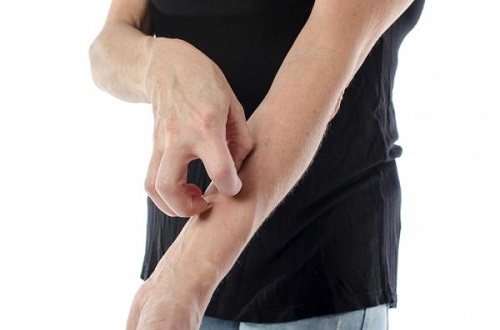
The essence of the problem
Warts appear on the skin due to the introduction of papillomavirus into the human body. Any adult patient has seen growths at least once in his life. The rashes can be localized on the neck, head, face, but most often they affect those areas that are vulnerable to injury - fingers and toes, heels.
The disease is especially acute in children and the elderly. The reason for this is weakened immunity. In healthy people, the virus remains in a latent state and does not manifest itself in any way. The growth of the tumor begins at the moment when the body’s protective reaction is disrupted. The following can speed up the development of the problem:
- pregnancy period;
- hypothermia;
- negative external factors;

- metabolic disorder;
- hormonal imbalances.
The size of condyloma varies from 2 mm to 5 cm in length. The larger the tumor, the more difficult it is to treat. Most often, vulgar (or ordinary) papillomas with a flaky surface are observed on the body of people.
Other types of growths should be noted:
- Flat or youthful, not raised above the skin.
- Genital warts, which are easily injured when touched carelessly.
- Senile keratomas.
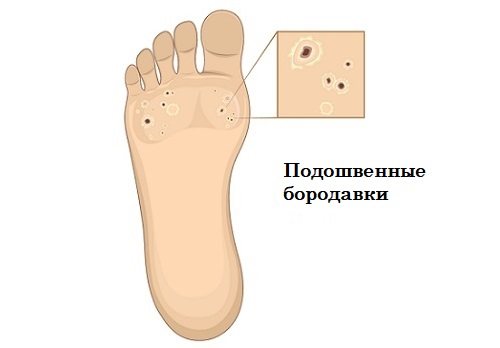
Do the listed types of warts itch or not? In normal condition, the growths do not itch or hurt. The main disadvantage of papilloma is that it causes a cosmetic defect, but does not in any way affect a person’s quality of life and health.
Causes of itching
Why might a wart itch? There are several reasons for the condition, but if the appearance of the tumor does not change, then there is no need to panic ahead of time. The reason to visit a doctor is a sharp increase in growth and discomfort when touching it. A rare cause of these changes is the degeneration of papilloma tissue into a malignant tumor. Much more often, harmless factors lead to the disease - injury, secondary infection, or aggressive exposure to sunlight. Each of the listed causes of wart itching should be considered in more detail.
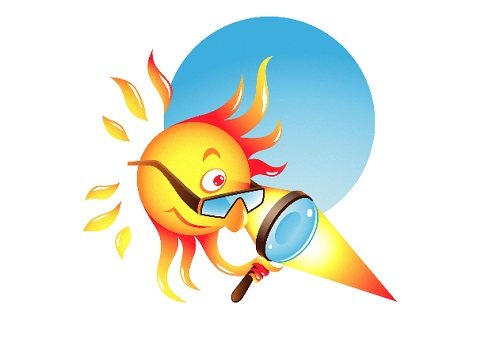
Damage to the build-up
A common reason for the growth and itching of condyloma is wearing uncomfortable underwear. This is especially true in cases where the tumor is localized on the abdomen, back or genitals. The problem can be solved by selecting appropriately sized items made from natural materials. Synthetic fabrics do not allow the skin to breathe, which provokes an exacerbation of epidermal diseases. Increased sweating and insufficient air exchange are ideal conditions for warts to increase in size and become red.
What does the symptom mean?
Warts are benign growths and normally should not cause discomfort. Therefore, it is worth knowing why warts itch and what to do if this symptom occurs.
This usually indicates the presence of complications, and additional diagnostics need to be carried out to determine the causes of this phenomenon. The growth may itch for the following reasons:
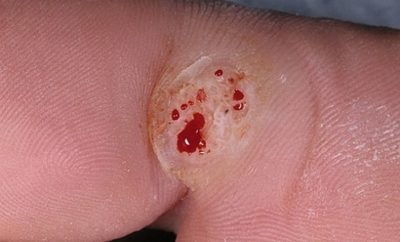
The surface of the neoplasm was damaged. This can happen due to mechanical or thermal stress.- The pathological process spreads, and due to the proliferation of damaged tissues, itching occurs.
- An infection entered the cells of the neoplasm and provoked inflammation. This also leads to burning or pain.
- The tissue located next to the growth (not the wart itself) is damaged.
- The transformation of neoplasm cells into a cancerous tumor occurs.
In other words, a wart itches for a variety of reasons, and sometimes it is not a sign of developing problems. A doctor who should be consulted can find out why this symptom occurs. In addition, the patient himself can also guess why this happens. To do this, you need to take into account other symptoms (if any).
An important circumstance is the duration of the unpleasant sensations that arise. If they are short-term, then there are no problems. Most likely, the surface closest to the growth was affected, which did not affect its condition in any way.
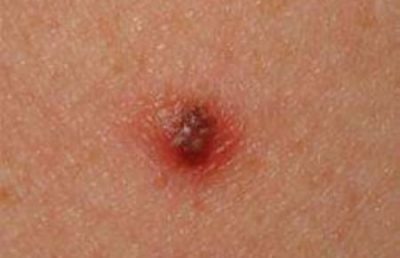
If the unpleasant phenomenon persists for more than 2 days, you should consult a specialist. The formation of pus around the growth indicates an inflammatory process and requires urgent treatment. It is especially dangerous if this phenomenon is accompanied by hyperthermia, weakness, nausea and other symptoms. It is necessary to establish what infection got into the wound and caused such a reaction.
If itching is caused by the growth of a wart, this does not mean that it has begun to degenerate into a malignant tumor. This is indicated not by a change in size, but by the fact that the growth takes on an irregular shape and also changes color.
Important! If this is exactly what is discovered, the help of a doctor is definitely needed. It is likely that such a tumor will have to be removed.
Thus, the question of whether warts itch can be answered in the affirmative. Moreover, this symptom does not mean that a dangerous pathological process has begun. Sometimes these are simply the consequences of a minor injury to the area.
Why is an itchy wart dangerous?
Does a wart itch or not when it turns into a tumor? One of the most dangerous causes of itching is the entry into the body of a pathogen with a high degree of oncogenicity. HPV provokes the development of cancer due to sun exposure; independent attempts to remove the formation; complications associated with soft tissue necrosis.
Immediate consultation with a doctor is required if the following symptoms are detected:
- rapid growth of the wart and change in its shape;
- pain when touching the growth;
- change in the structure of papilloma.

Itching without additional symptoms signals the rapid proliferation of HPV in the body. Soreness in the area is a symptom of an infected wart. If blood is released from the lesion, this may be a sign of destruction or proliferation of vascular tissue.
How to Deal with Itching Symptoms
To relieve signs of itching, pharmaceutical products with a sedative effect are used. Women during pregnancy should take medications only under the supervision of a doctor. Many drugs used to combat pathology are prohibited when carrying a child, since they negatively affect its growth and development.
For temporary relief of itching, ointments and creams are used for local treatment of problem areas. If the epidermis is peeling, then preference is given to gels with a fatty composition and a cooling effect:
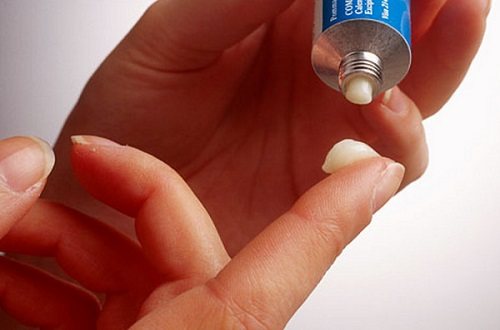
It is desirable that the agent used has several actions at once: antihistamine, anti-inflammatory, antimicrobial. For signs of severe itching, creams and ointments are used:
Medicines are used only with the permission of a doctor. Many of the listed creams have contraindications, for example, violation of the integrity of the epidermis.
Treatment of itchy warts requires an integrated approach, especially if the tumors are located in the genital area. The excreted feces and urine corrode the surface of the papilloma and cause its secondary infection with staphylococci, gonococci and other types of bacteria. In this case, your doctor will help you develop a competent treatment regimen. If the problem is diagnosed in women, they are advised to change panty liners frequently.
Additionally, doctors recommend adhering to the following rules:
- do not touch or scratch the wart;
- regularly wash the affected area with soap;
- wear loose clothing made from natural fabrics;
- stop using woolen items;
- treat the growth with iodine and camphor oil;
- Take antihistamines orally if signs of itching worsen.
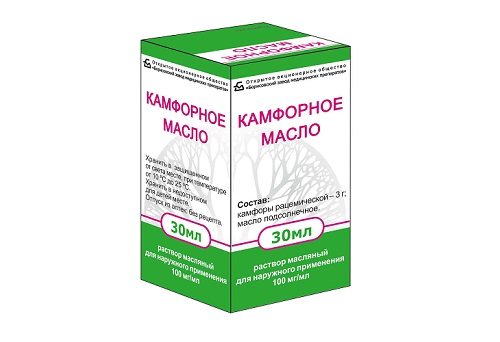
Prompt ways to solve the problem
It is recommended to remove all warts located in easily injured areas. There are many methods for bloodless and painless removal of growth. These include:
- laser radiation;
- cryodestruction;
- electrocoagulation.
The essence of the first procedure is layer-by-layer removal of papilloma using heat. Another way to cauterize a growth is to use liquid nitrogen. The method has virtually no contraindications and is especially effective in the early stages of the disease.
Along with surgical treatment, it is recommended to take a course of vitamins to strengthen the immune system. An integrated approach will increase the chance of full recovery. If HPV is present in the body, it is necessary to promptly treat chronic ailments in order to avoid the multiplication of the viral pathogen.
